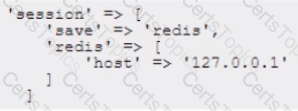Adobe Related Exams
AD0-E718 Exam



The development of an Adobe Commerce website is complete. The website is ready to be rolled out on the production environment.
An Architect designed the system to run in a distributed architecture made up of multiple backend webservers that process requests behind a Load Balancer.
After deploying the system and accessing the website for the first time, users cannot access the Customer Dashboard after logging in. The website keeps redirecting users to the sign-in page even though the users have successfully logged in. The Architect determines that the session is not being saved properly.
In the napp/etc/env.php\ the session is configured as follows:

What should the Architect do to correct this issue?
In a custom module, an Architect wants to define a new xml configuration file. The module should be able to read all the xml configuration files declared in the system, merge them together, and use their values in PHP class.
Which two steps should the Architect make to meet this requirement? (Choose two.)
An Adobe Commerce store owner sets up a custom customer attribute "my.attribute" (type int).
An Architect needs to display customer-specific content on the home page to Customers with "my.attribute" greater than 3. The website is running Full Page Cache.
Using best practices, which two steps should the Architect take to implement these requirements? (Choose two.)